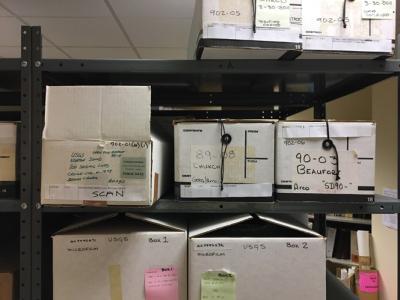By Ashley Ace
Geographer, Resource & Economic Analysis Section
BOEM Alaska OCS Region
Alaska has no Ikea. There are no Trader Joes, no Chick-fil-As, and “two-day” Amazon Prime shipping can stretch into weeks.
But while Alaska has a reputation for being behind the curve in certain areas, the Bureau of Ocean Energy Management Alaska Outer Continental Shelf Region is ensuring that stereotype does not apply to our data management. We are deploying innovative strategies to modernize our data by utilizing Open-Source Software (OSS), automation, and the fundamentals of computer programming. From operational efficiency to resource optimization, data management is critically important in the federal government. It is essential for maintaining the quality, security and accessibility of data, ensuring that agencies like BOEM can fulfill their obligations to the public.
A unique challenge facing the Alaska Region is our magnitude of non-digital data of various formats including mylar, 35 mm slides and field notebooks (figure below). A lack of easily accessible data creates unnecessary challenges in our day-to-day workflows. To modernize our operations, we are developing custom applications to optimize the extraction, transformation and loading of our non-digital data.
Many of the applications we develop are written in Python, a popular programming language for various data-related tasks from simple data manipulation to complex machine-learning applications. Programming these applications in-house gives us the autonomy to write code that fulfills specific end-user feature requirements related to metadata tracking, data domains, interface design and end-user workflow efficiencies. Scripting custom functionality ourselves is crucial to ensuring the accuracy and standardization of data as it is ingested into a database. We use a database storage solution for efficient data retrieval, analysis and integration with other systems. These efforts are transforming a room of unstructured data into a virtual repository of information easily searched and accessed from your laptop.
Alaskans have a deep connection to the environment, while also acknowledging the unique challenges and strategic significance of the Arctic region. BOEM’s Alaska OCS Region believes accurate data management is essential to environmental stewardship. Digitizing paper maps, for example, allows us to use spatial data to evaluate suitable locations for carbon sequestration storage and renewable energy potential while considering environmental impacts. Additionally, Alaska is rich in oil, gas, minerals and other natural resources. Accessible, structured and query-able data is essential for interpreting surveys, mapping resource volumes and modeling the economic value of these resources. By effectively managing data, the Alaska Region can responsibly develop energy initiatives that minimize environmental impacts and contribute to the energy security of the Arctic ecosystem.


